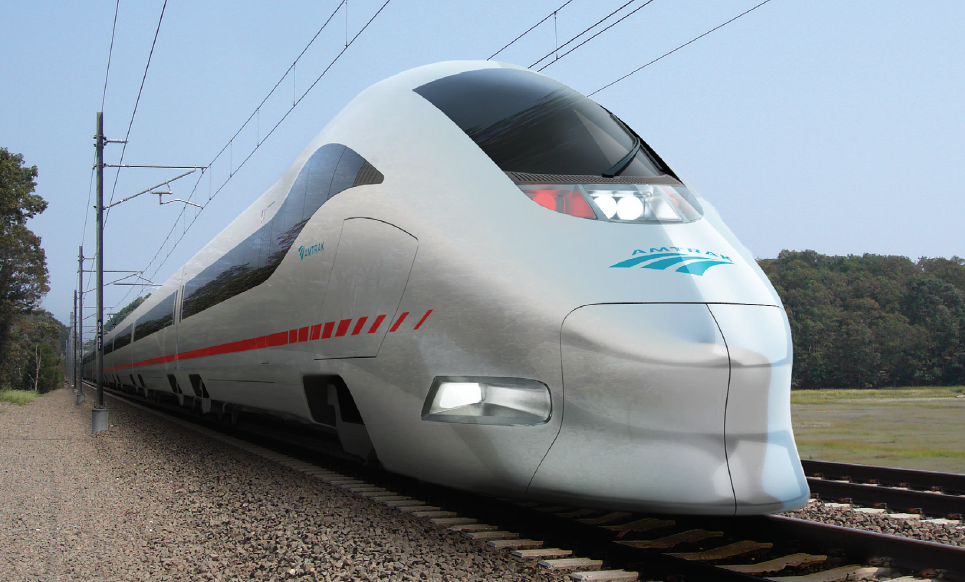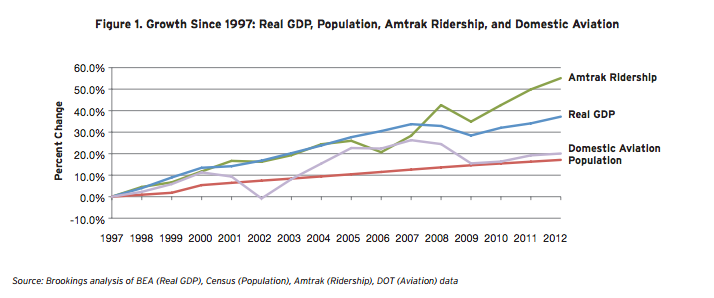
Last week, the Metropolitan Policy Program at the Brookings Institute released a report on the state of Amtrak and the American railway system. The report, entitled “A New Alignment: Strengthening America’s Commitment to Passenger Rail,” reveals the importance of trains to the transit needs of the everyday American traveler.
Because of its poor public image and massive deficits, Amtrak is often disregarded as a historical artifact, inefficient and ineffective for the modern passenger. With deficits exceeding $600 million–a cost that goes straight to the taxpayer–politicians have questioned the value of America’s train system and have struggled to find ways of funding it. To say the least, trains are not at the top of the national discourse on public transportation.
The Brookings report, “A New Alignment,” is extremely valuable for uncovering Amtrak’s promising successes from the midst of the negatives. Surprisingly, train travel has increased in popularity more than any other mode of domestic transportation, outpacing both aviation and automobiles; in 2011, Amtrak reached an all-time record of 31 million passengers. While most of Amtrak’s trains are exorbitantly expensive to run and manage, there are routes that make money, especially in the area surrounding New York City. The star examples are the Acela and the Northeast Regional routes, which generated over $200 million of Amtrak’s income and account for 17.4% of Amtrak’s ridership.

The statistics for New York’s regional railways are impressive. In 2011, New York had about 10,855,647 riders on its regional transit system, which is an increase of 22.9% since 1997, outpacing both the rate of population growth (which was 10.6%) and the rise in economic output. Although none are quite as exemplary, most regions demonstrate similar patterns. Routes that were less than 400 miles generated $46.6 million while the routes that were longer than 400 miles lost $613 million. This may be because the routes under 400 miles carry 83% of Amtrak’s passengers or because shorter routes require less maintenance.
The Brookings report demonstrates an important change in the way that Americans use train travel, in our understanding of how transit systems should function, how different systems should work with one another, and how they should be developed in the future. The patterns also demonstrate the ways in which the organization of the contemporary American landscape has changed. It is no longer a series of distinct metropolitan centers surrounded with rings of suburbs. Instead, we have a fabric of cities and suburbs with areas of increased or lesser density that continues more or less uninterrupted across vast portions of the landscape. Development extends across city and state lines, and as such, transportation can no longer be conceived as independent metropolitan systems.
Trains are an incredibly sustainable mode of transportation. On a per-mile, per-passenger basis, trains produce less than half the emissions of a car or a plane. Of course, a passenger will choose his mode of transit based on the convenience and the price, which means the next step in innovating a national functional rail system that will make train travel the preferred mode–at least for trips of a certain length. A system upgraded to high speed rail could potentially convince consumers to not drive or fly on many mid-length routes, massively reducing emissions, congestion, and smog. For city-center to city-center business travel, rail has a natural efficiency advantage over commuter jets, as it doesn’t require the trip in from an outlying airport.
Taken for granted in Europe and Asia, high speed rail systems are conspicuously absent from America’s transit plans. Amtrak’s existing trains that run on northeastern lines do have the capability of running at high speeds (up to 160 mph), but average only 81.8 mph due to congestion and track curvature. The capacity to run these trains at full speed thus requires a major investment in infrastructure.

California’s high speed rail proposal, a connection that would link northern and southern California and would complement the existing regional system, has the momentum, political will, and, most importantly, funding, to be realized within the next few decades. The environmental benefits are also remarkable–if the electric trains are powered by a renewable source of energy, the system has the potential to be carbon neutral, and, considering the cars it would take off the road, would overall reduce emissions and raise air quality in California. Once completed, California’s high speed rail will be an important case-study for the development of other high speed rail networks across the United States.
The New York region could easily benefit from a high speed system. If installed between New York and Washington DC, the trip could be reduced to 94 minutes.
If you are interested in learning more about the state of Amtrak, check out the complete Brookings Report and the attached interactive graphic that helps to elucidate the problems and success of the American rail system.